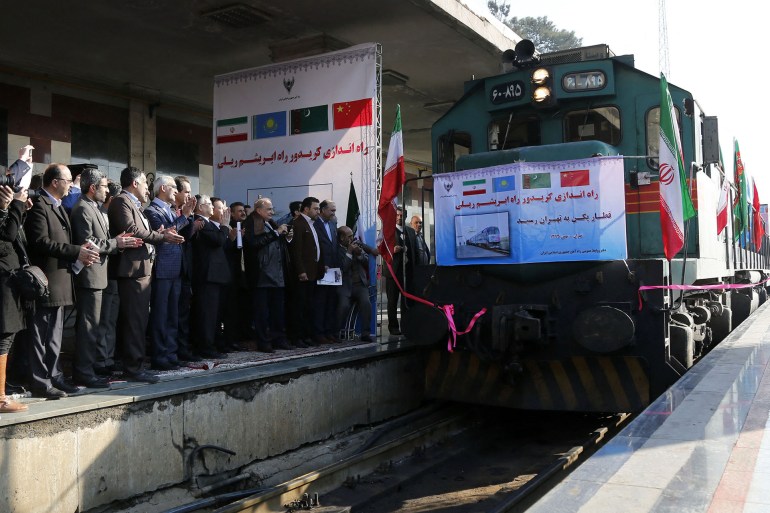Having planned for decades to play an active role in international transport, the Iranian government has made efforts in the past months to restore its strategic position on the "transit" lines linking East Asian countries with the European continent, as well as facilitating trade between China and Russia, which have long-term strategic agreements with Tehran. .
Since the outbreak of the war between Russia and Ukraine more than 4 months ago, Tehran has found in international threats to close the land transit corridors between Russia and European countries an opportunity to increase its share of global trade, which Iranian Vice President Mohammad Mokhber described as profitable and providing job opportunities for his country.
Mokhbar described the opportunity for international transport as one of the main advantages of Iran, stressing that "transit" can be a suitable alternative to oil revenues, and also instructed the Ministry of Roads to prepare a comprehensive plan to develop the transport sector within 3 months.
transmission network
After Iran officially inaugurated last week the International North-South Transport Corridor (INSTC), last Sunday it received a container transport train on the railway transit route linking Kazakhstan, Turkey and Europe through Iranian territory.
In the meantime, the Iranian media reported last week the launch of the international freight train from the Chinese region of Ningxia towards Iranian territory, stressing that the train will reach the country after 20 days after passing through Kazakhstan, and its cargo will be transported across the Caspian Sea towards the port of Anzali, then to other countries to the east. and westward.
In order for Iran to become a vital link between Asia and Europe, it is necessary to activate all transport lines that pass through Iranian territory, according to economic researcher Muhammad Mawlawi, who believes that his country's geographical location enables it to attract a large part of global trade.
Moloy explained to Al Jazeera Net that more than 5 international corridors pass through Iranian territory, perhaps the most important of which is the North-South corridor that connects India and Russia, the Traceka corridor, which represents a bridge between the countries of Central Asia and the European continent, and the ancient Silk Road corridor linking East Asia, the Mediterranean and the Caucasus countries , along with other corridors that were not fully completed due to the lack of the necessary infrastructure.
Iran enjoys many large ports, road transport networks, and railways extending to the borders of neighboring countries (French)
Distinctive geography
The Iranian researcher believes that the geographical location of his country is between the Gulf waters in the south and the Caspian Sea in the north, in addition to its enjoyment of many large ports and land transport networks and railways extending to the borders of neighboring countries;
These are reasons that contribute to short distances and reduce the cost of transporting goods, especially between East Asian and European countries.
Moloy added that among the active corridors in Iran, the North-South corridor reduces the period of transporting goods by 20 days and reduces the cost by 30% compared to the road that passes through the Suez Canal, and that transporting Chinese goods by train through Iran saves 20 days and about $900 per container. compared to the previous route.
Referring to his country's signing during the last Iranian year (end last March 21) of strategic cooperation agreements with China and Russia;
Mollavi concluded that Tehran sees international transportation as an opportunity to advance its beleaguered economy and circumvent Western sanctions, along with the expected resources by activating the network of international corridors.
He concluded by saying that the government of President Ibrahim Raisi pays great attention to developing its trade relations with neighboring countries, and that it has been working since the first day of its assumption of power about a year ago to link the national economy with the development movement in China, Russia and India, and urged these countries to invest in Iran.
The Iranian government attaches great importance to developing its trade relations with neighboring countries (IRNA)
Infrastructure
The last meeting of the "transit" working group in Iran - which was attended by the ministers of economy, interior, roads and defense, the head of the Planning and Budget Organization and the head of the Center for Strategic Studies at the Presidency of the Republic - reached the conclusion that the transit transport sector is capable of providing revenues of $20 billion annually, as well as About his ability to provide one million job opportunities in the country.
On the other hand, political geography researcher Farzad Ahmadi warns that his country will miss the opportunity to become a link between the West and the East in the absence of the necessary infrastructure for international corridors, adding that the destabilization of security in a number of neighboring countries and the wars that the region witnesses from time to time represent great challenges. In front of the booming transit sector in Iran.
Ahmadi added - in his speech to Al Jazeera Net - that some of the Iranian roads that are located in the international corridors have not yet been completed, and that they need to extend railways, which led some countries - including China - to plan to establish parallel corridors such as the New Silk Road.
The Iranian researcher urged his country to work to activate the corridors of oil and gas pipelines to feed the eastern and western markets with the energy of the Middle East, stressing that Iran, through its view of the Indian Ocean and the Caspian Sea, can get great returns from the transit sector, especially since it is surrounded by a number of landlocked countries. .
The Iranian researcher criticized his country for relying on China and Russia to advance its economy, describing Russia as a competitor to the Iranian economy, and urging Tehran to work to overcome political obstacles with neighboring countries to form a gateway for its goods to global markets, east and west.

